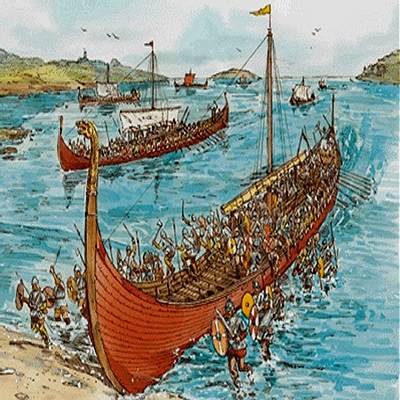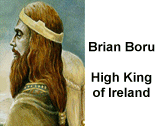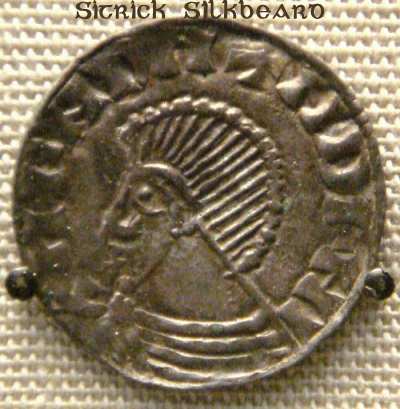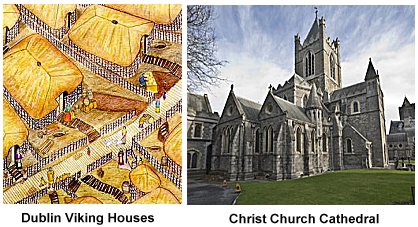The Vikings originated in Norway and Denmark and began their legendary raids during the eight century. The history of the Vikings in Ireland stretches
back to that time and culminates with
their defeat by Brian Boru at the Battle of
Clontarf in the year 1014.
The earliest recorded raid from Vikings out of
Norway was in the year 795 at Rathlin Island
off County Antrim.

In the year 798 they raided the kingdom of Brega near the northern part of Dublin. These initial raids involved rapid landings, then plundering the local settlements and Monasteries before retreating back to the sea.
The Scottish isle of Iona
was also attacked in the same year. By the year 802
the raids had stretched around the western coast
as far as Skellig island and the ancient Monastery
there.
By the year 832 an intensification of the
attacks occurred with fleets of Viking ships
arriving at the Boyne, at Dublin and travelling
the Shannon estuary. They took supplies, riches
and slaves.
Early Viking leaders who raided Ireland include Saxolb in the year 837, Turges in the year in 845, and Agonn in the year 847. By the end of the ninth century the Vikings began to establish settlements known as 'longports' along the Irish coast. These were essentially coastal forts that protected the Viking boats. The earliest of these were at Linn Dúachaill (Annagassan) in County Louth and Duiblinn on the River Liffey, the forerunner of what would become Dublin, the capital city of Ireland.
The word Viking is taken from the Norse
word 'Vikingr' which means 'sea-rover' or 'pirate'.
Their longboats gave them an advantage that other
sea-faring peoples just could not match. Their
fierce attacks must have instilled terror into
the local population and especially at the
Monasteries where much of the wealth they craved
was located. It is no coincidence that the number
of high-towers built for protection in Ireland
greatly increased during this era.
By this time the Viking Chiefs Olaf and Ivar controlled the raids, some bringing as many as 1500 fighting men in many longboats - a veritable army.
The Irish chieftains now began their defence in
earnest since, as the Vikings had begun to make
semi-permanent settlements they had become a
much easier target. The Irish chieftain Máel
Seachnaill is recorded as having routed the
Vikings at Skreen in County Meath, putting over
700 of the invaders to death. Alliances between
the Vikings and the Irish chieftains became
commonplace as the presence of the norseman
became a political inevitability to be
acknowledged and dealt with.
By the year 849 invaders from Denmark had begun
to attack not only the Irish but also the more
established Vikings of Norwegian origin. By
853 'Olaf the White' had assumed control of
Dublin. He married the daughter of Áed Finnliath,
king of the northern Uí Néill. Decades of warfare
with some victories and some defeats for the
Vikings followed. In the year 902 the Irish
defeated the Vikings at Dublin.
A second wave of attacks began in the year 914
with a large fleet of Vikings ravaging Munster.
Over time the Irish fought back with some success.
The Dublin Vikings were attacked by the King of
Tara, the city sacked in the year 944.
The stage was set for a great showdown between
the two cultures with Brian Boru of Dál Cais
in County Clare being the spear-point of the
Irish attack. He had already defeated the Vikings
in Munster. His great rival was Máel Sechnaill II,
King of Tara. They reached an accord in the year
977 that Brian Boru would rule the southern part
of the country with Máel Sechnaill II ruling the
northern part.

They even collaborated on a raid
against the Dublin Vikings in the year 998. By
the year 1000 Brian Boru had put down a revolt by
the Dublin Vikings, defeating Sitric and
eventually forcing Máel Sechnaill II to
acknowledge him as the High King of all of Ireland.
The Leinster Vikings again revolted in the year
1012 but were once again defeated. They knew that
their time was limited so they sought help from
Sigurd, Earl of the Orkneys, who arrived in the
early part of 1014 to face the Irish.
The famous battle of Clontarf ensued with the
Irish squaring up to Sigurd, Brodar and Ospak
who were Vikings of the Isle of Man. With
Brian Boru, Brodar and Sigurd all killed in the
fierce battle that followed the Vikings were
eventually defeated, the battle entering the
pantheon of myth and legend of Viking history.

Estimates of the number of dead range from 6000
to over 12000, a huge number for warfare of
that time.
The Viking defeat at the battle of
Clontarf effectively signalled the end of Viking
rule in Dublin and thus throughout the country.
Long before this battle though the inevitable
integration of the two cultures had begun. The
invaders even assimilated the native Christian
religion, forming alliances, marrying and
eventually settling among the native Irish.
The legacy of the Vikings in Ireland is extensive.
The towns of Dubin, Cork, Wexford, Limerick and
Waterford that were initially founded by the
Vikings all developed into the major cities of
the modern era.

A full-scale invasion of the
island was never attempted as the Vikings had
matters in England and France to deal with.
Thus, despite the attacks, the native Irish
chieftains continued to prosper and make
treaties, war with each other and the Vikings,
sometimes allying with the 'norsemen' against
rival chieftains.
Coinage was first used in Ireland during the
Viking era further providing evidence of the
degree to which the Vikings changed from being
raiders to merchants and settlers. Dublin was
especially transformed by their presence, with
Christ Church Cathedral being built by Sitric.
The layout of the city centre today is much as
it was originally designed by the Vikings.
Further proof of their integration survives the centuries
through the use of surnames. Families of
McAuliffe (son of Olaf), McManus (son of Manus),
Doyle (the dark stranger or foreigner),
McLoughlin (son of Lochlainn) and McIvor (son of
Ivor) are just a few of the many 'Irish' names
that have deep roots within the Viking heritage.
The death of Brian Boru marked a period of further
fighting among the native Irish culminating with
the Anglo-Norman invasion in the year 1169 and
the beginning of a new period of warfare. It is
a tragic fact of Irish history that the various
chieftains and tribes remained so divided,
unwilling to create a central leader or kingship
capable of unifying opposition on the island to
the centuries of foreign invasion and hostility that were to follow.

 In the year 798 they raided the kingdom of Brega near the northern part of Dublin. These initial raids involved rapid landings, then plundering the local settlements and Monasteries before retreating back to the sea.
In the year 798 they raided the kingdom of Brega near the northern part of Dublin. These initial raids involved rapid landings, then plundering the local settlements and Monasteries before retreating back to the sea.
 They even collaborated on a raid
against the Dublin Vikings in the year 998. By
the year 1000 Brian Boru had put down a revolt by
the Dublin Vikings, defeating Sitric and
eventually forcing Máel Sechnaill II to
acknowledge him as the High King of all of Ireland.
They even collaborated on a raid
against the Dublin Vikings in the year 998. By
the year 1000 Brian Boru had put down a revolt by
the Dublin Vikings, defeating Sitric and
eventually forcing Máel Sechnaill II to
acknowledge him as the High King of all of Ireland.
 Estimates of the number of dead range from 6000
to over 12000, a huge number for warfare of
that time. The Viking defeat at the battle of
Clontarf effectively signalled the end of Viking
rule in Dublin and thus throughout the country.
Estimates of the number of dead range from 6000
to over 12000, a huge number for warfare of
that time. The Viking defeat at the battle of
Clontarf effectively signalled the end of Viking
rule in Dublin and thus throughout the country.
 A full-scale invasion of the
island was never attempted as the Vikings had
matters in England and France to deal with.
Thus, despite the attacks, the native Irish
chieftains continued to prosper and make
treaties, war with each other and the Vikings,
sometimes allying with the 'norsemen' against
rival chieftains.
A full-scale invasion of the
island was never attempted as the Vikings had
matters in England and France to deal with.
Thus, despite the attacks, the native Irish
chieftains continued to prosper and make
treaties, war with each other and the Vikings,
sometimes allying with the 'norsemen' against
rival chieftains.
